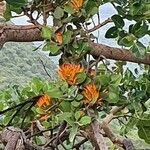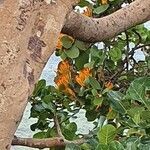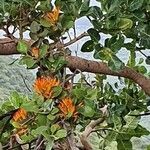Corolla 4.5–6 cm long, orange-red with red filament lines, lobes sometimes reddish but tips cream inside, tomentellous with grey stellate hairs and very short red-brown dendritic hairs less than 0.5 mm long, often slightly glabrescent on basal swelling; apical swelling of bud 4–5 × 3.5–4 mm, ovoid-ellipsoid, apiculate, slightly 5-ribbed; basal swelling 5–7 × 4 mm; lobes erect, 1.1–1.3 cm long; tips 4–5 × 2–2.5 mm, elliptic, conspicuously hardened inside.
Leaves subopposite to irregularly ternate, subsequently clustered on short shoots; petiole 2–10 mm long; lamina grey-green, coriaceous, 3–15.5 × 0.5–1.5(2.5) cm, linear-lanceolate to narrowly elliptic-oblong, tapered at either end, acute to obtuse, with minute grey stellate hairs and very short evanescent red-brown dendritic hairs, glabrescent, with 4–8 pairs of lateral nerves soon becoming obscure.
Umbels confluent around old axils, mostly after primary leaves have fallen and often below tufts of new leaves, sessile, 2–4-flowered; pedicels 1–3 mm long; bract 3–5 mm long, ovate, ± acuminate, tomentellous to glabrate.
Branches mostly pendent, 0.7–2 m long; branchlets tomentellous with short dentritic mostly red-brown hairs, soon falling to leave covering of grey stellate hairs and scales, glabrescent.
Style red, generally distinctly lobed opposite top of corolla tube, slightly tapered to neck; neck 2–2.8 mm long.
Berry blue-green, 1.5 × 1 cm, ellipsoid, with fine rufous stellate pubescence; seed blue-black.
Stamen filaments red on lower part; anthers 2–2.8 mm long, with 6–8 cells in each row.
Receptacle 2.5–3 mm long, obconic to broadly barrel-shaped, tomentellous.
Calyx 1.5–2 mm long, truncate to slightly lobed, less hairy, ciliate.



